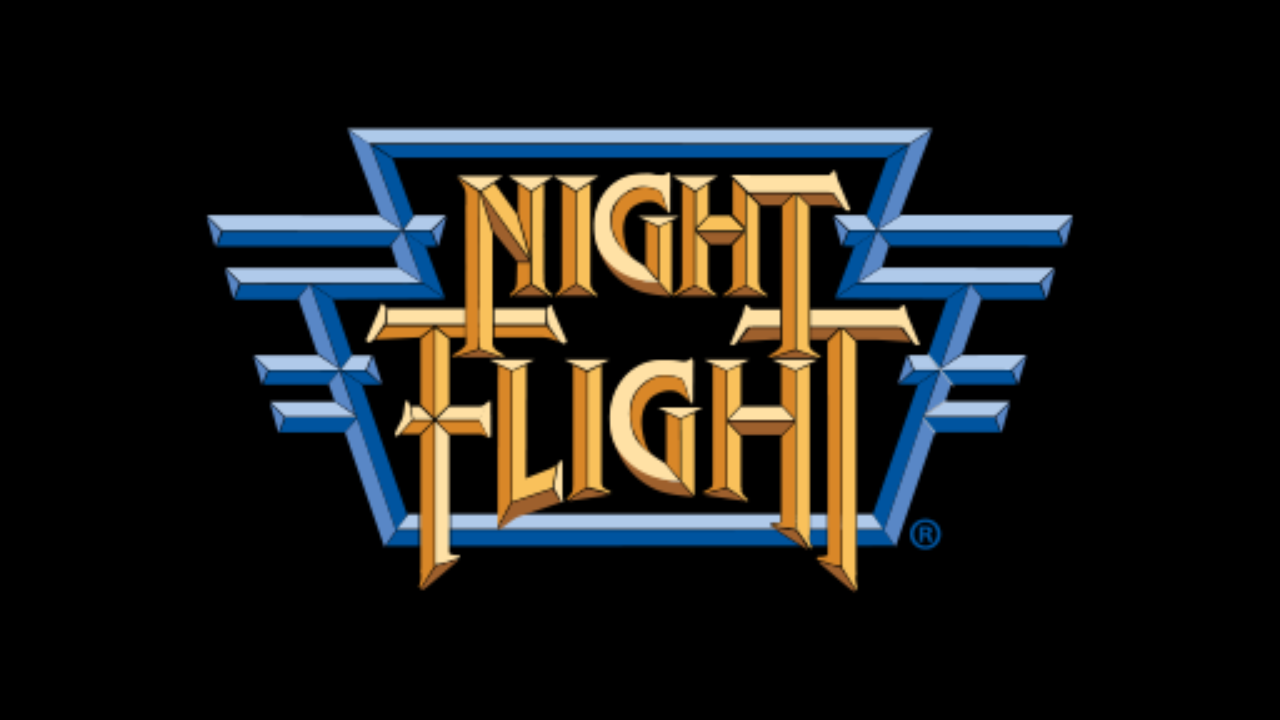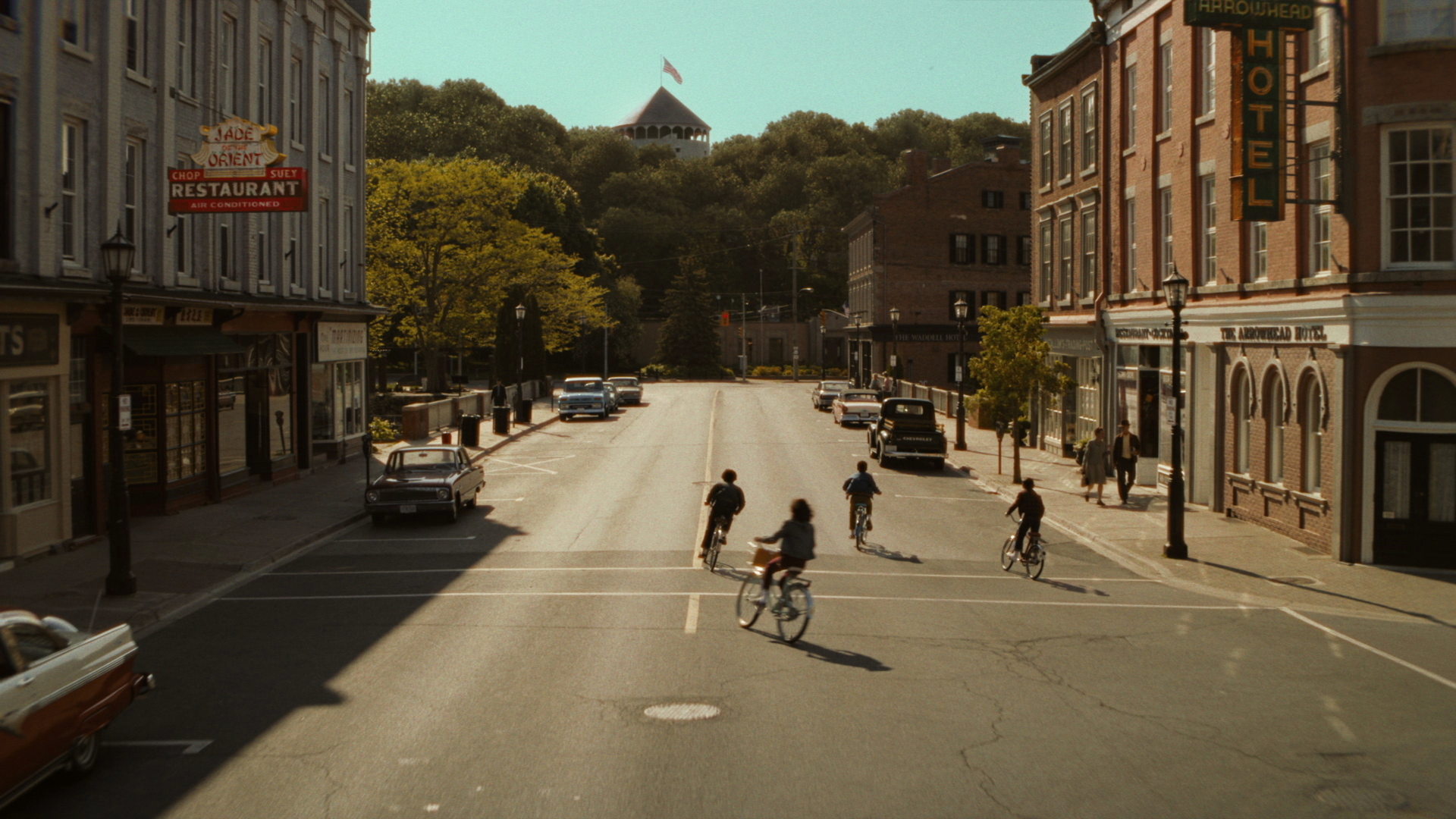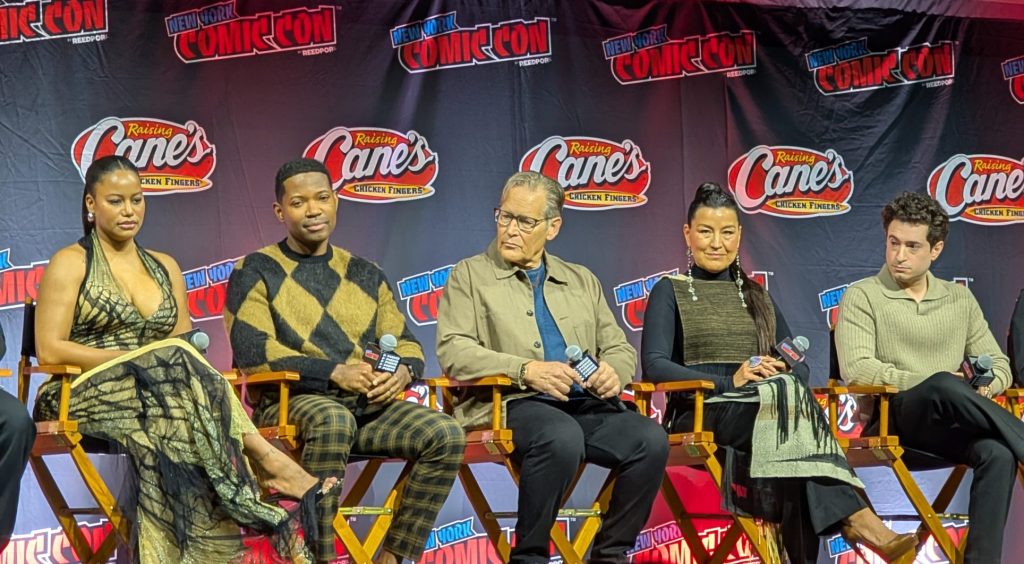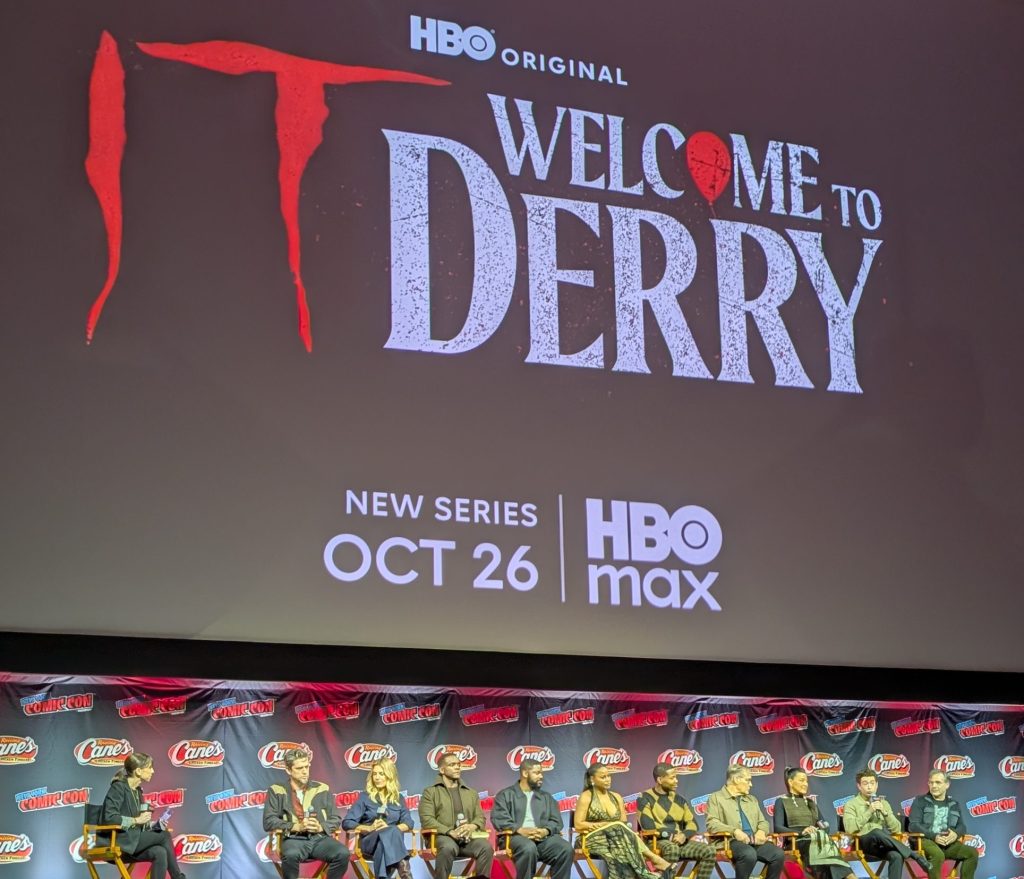TV
Our Favorite Horror Homages and Easter Eggs in ‘The Boulet Brothers’ Dragula’ Season 2

The Boulet Brothers’ Dragula is a show made with a crazy amount of love and laden with an even crazier amount of horror references and in-jokes for the fans. With some being obvious and some being deep cuts, we look back at our favorite horror references in the best drag show on television.
Our Favorite Horror Homages in The Boulet Brothers’ Dragula
Bleeding Boardrooms Dry, Scanners Style
This opening of the season really did set the tone for it all. Here, the Boulet Brothers have a short-lived and very one-sided clash with some television producers who are trying to stop the show from airing. Taking a page from the book of Cronenberg’s Scanners, the duo exerts their telekinetic powers on the white-collar nuisances to gruesome effect. The show must go on, no matter who must die for it.
Felony Dodger’s Texas Chainsaw Massacre Death
Perfectly white surfaces and blood splatter. Has there ever been a better aesthetic duo for horror? In the season’s first extermination, Felony Dodger’s demise by chainsaw reminded us of the chase sequence in 2006’s The Texas Chainsaw Massacre, with the clotheslines being her final resting place as Felony gets dismembered by the Boulet’s chainsaw.
Abhora’s Art the Clown Inspired Look
Episode 2 saw a lot of incredible looks to evoke that theme of the old west ghost town, but fans of All Hallows’ Eve and Terrifier will notice Abhora’s monochrome, turn of the century makeup giving a whole lot of Art the Clown energy, especially when she gives her maniacal smile. How absolutely…well, terrifying!
Monikkie’s Take on Patience Buckner…
Another second episode look, this contestant who was exterminated untimely shared a lot of mannerisms and similarities with the sympathetic Patience Buckner, the youngest antagonist of Cabin In The Woods’ Buckner Family. She fits right in with everyone’s favorite zombie redneck torture family with her pigtails, dress, and slow-moving ghoulish performance. Just don’t call her a normal zombie, or Hadley & Sitterson won’t shut up about it.
…And Her Halloween Tribute Extermination
In what was by far my favorite extermination short film of the season, Monikkie’s signature mask took the place of a young Michael Myer’s Halloween costume. Instead of a child-sized clown, the masked queen fell prey to a mysterious killer wearing her very mask. If only we knew who could have done such a horrible thing? And more importantly, who did the killer’s nails? They look incredible!
Victoria Elizabeth Black channels the OG Dragula Driver
With episode 3 being all about rock and roll, what is more fitting than Victoria Black’s costume being a tribute to the singer-songwriter who gave us the absolute banger “Dragula”? The top-hat and dreads combo and the macabre makeup are a classic Rob Zombie look.
Israel and the Aliens
This one was more of a broad homage to the campy sci-fi and horror films of the 50s and 60s and the forefather of all horror television, The Twilight Zone. Here, we get a little origin story on everyone’s favorite tattooed manservant, Israel, where we see his former life as a police officer who, investigating the sight of the crash, meets two out of this world queens that immediately take the role of his masters.
Dahli Goes to Camp
Like Angela from Sleepaway Camp, Dahli’s killer decided to implement the kitchen as their murder weapon. However, rather than frying the victim, Angela was baked alive in a smoky, oven-fired death. The camerawork and the kill are undoubtedly reminiscent of the exact sequence where predatory camp cook Artie meets his demise.
Erika Klash, Meet John Bishop
The anime and J-Pop inspired friend to all met her match in Episode 5 and suffered some voodoo indignities in her death. Chucky fanatics (like myself, I mean, I DID cover the whole series here) will recognize this mirrors the death of Charles Lee Ray’s mentor John Bishop in Child’s Play, who suffers blunt force magical trauma. I guess this time she was just all voodoo dolled up with nowhere to run.
Disasterina Goes Psycho
In what is the most cut and dry of references in the Extermination films, Disasterina got the cold shoulder under some hot water in Episode 6. Her shower death mimicked Marion Crane’s in the 1960 classic Psycho. While the parody has been done hundreds of times, Disasterina does bring it quite a bit of charm with the A-Tier camp she was carrying throughout the season.
Immortan Drac and Immortan Swan
Less of a horror reference and more of a fun little easter egg for all of us Mad Max fans out there, our return to the wasteland saw us meeting up with a not-so-alien iteration of the Boulets. This time around, they were channeling Immortan Joe of Mad Max: Fury Road fame, watching the bombs drop with delight and two tall glasses of gasoline.
Meatloaf, Meatball, Same Thing Right?
The most complex of the episode intros, the reunion episode saw a cameo from famed drag queen Meatball, who took her place in a very layered and perfectly executed parody of Rocky Horror Picture Show. Meatball takes the place of Eddie, who comes out of a deep freeze in the film and is played by the late great singer Meatloaf (isn’t it a great play on words?). Of course, the Boulets eventually kill Meatball with an expertly placed knife throw. That is, before they go full Drayton Sawyer on the thawed-out victim and serve them to the Season 2 contestants. Hey, the girls have got to eat!
How many of these were you able to spot on your first watch-through? Let us know in the comments, and stay tuned for more The Boulet Brothers’ Dragula articles!
Make sure you check out seasons 2-3 of The Boulet Brothers’ Dragula now streaming on Shudder.
TV
Is Night Flight Plus Your Next Favorite Streamer?

As genre fans, we see a lot of streamers vying for our dollars and promising to give us the gory goods. In addition to the usual suspects, we usually get a handful, geared specifically towards genre fans, that pop up every once in a while. While some deliver and stick around, like Shudder, others end up leaving us nothing but fond memories, like Chiller. With streamers like Arrow Video, Midnight Pulp, Screambox, Scream TV, etc., it’s hard to know which apps are worth the time and money anymore. Which is why, after learning about Night Flight Plus at Brooklyn Horror Film Fest, I decided to take this streamer for a test drive. I ran through the library and took notes to help you figure out if this site deserves a slot in your streaming app lineup. Let us dive in.
What Even Is Night Flight Plus?
First things first, Night Flight Plus is not just a horror app. It launched in 2016 and is built around the 1980s USA Network series Night Flight. So, they have episodes of that show and walk a fine line between genre and music documentaries. The site celebrates counterculture. Meaning there is a ton of cool stuff for film and music nerds alike. While a lot of their horror movies can be found on other apps (look right at Shudder and Kanopy), they have a robust animated film section and a ridiculous amount of short films. So, it is setting itself apart from most other streamers simply by having a decent-sized smorgasbord of random cool stuff. I personally have my eye on New York Dolls – Lookin’ Fine On Television if I have time to step outside of the horror space while playing on the app.
What Movies Are Streaming This Month?
This month’s categories of note include: Black Phone 2: Curated by Director Scott Derrickson. Derrickson proves he has a taste and has assembled a lineup which includes Tetsuo: The Iron Man, Opera, a 1988 video profile of John Carpenter, and a handful of documentaries about film and music.
In keeping with the Black Phone 2 theme, Night Flight Plus also has: Black Phone 2: Late-Nite Faves 1980-82. This section includes The Boogeyman (1980), Fade to Black, Butcher, Baker, Nightmare Maker, and Dark Night of the Scarecrow. It also has the movie that introduced me to the world of Frank Henenlotter, Basket Case.
However, it’s the Japanese Horror section that pulled me in. Evil Dead Trap, Evil Dead Trap 2: Hideki, Bloody Muscle Body Builder In Hell, Dead Sushi, and Madame O. While some can be found in other corners of the internet, a few are movies that have eluded me for years. So, I will definitely be making time to cross these off my list while I have access to this app.
But Wait! There’s More!
Night Flight Plus also offers label showcases for companies like Yellow Veil, Severin Films, Blue Underground, and Arrow Video. The eclectic categories also include sections of work directed by Lucio Fulci, Dario Argento, and Antonio Margheriti. I also appreciate the thought to add “Blaxploitation, Mob Action and Rough Street Justice” and include Black films off the beaten path. Action fans might want to check out the Bruceploitation Collection, featuring 11 Bruce Lee films at the moment. Overall, the streamer feels like one of those restaurants that dabbles in various kinds of cuisine, and you have to figure out where it excels.
Because memberships are as low as $6.99 per month (or $59.99 for an annual unlimited access), I think it is worth checking out for a month or two. If things get serious, you can definitely think about making a long-term commitment. To sweeten the deal, Night Flight Plus is available on Roku, Apple TV, iPhone, Android, Amazon Fire TV, Samsung Smart TV, Chromecast, Google Play, and Sony. You can also view their library on a web browser if none of those options work for you.
Night Flight Plus is currently offering seven-day trials for people who want to try it before they buy it. They also allow you to have the service on as many devices as you please, unlike Netflix. So, if you’re looking to get into some fringe, cult, and punk cinema, you might want to give it a whirl. However, if none of these deep cuts and nearly forgotten gems get you excited, then this isn’t the streamer for you.
You can check out Night Flight Plus here.
TV
Everything We Learned About HBO Max’s ‘It: Welcome to Derry’ at NYCC 2025

Do you know what time it is? It’s time to float, baby—because Stephen King’s It is returning to our screens! Developed by Andy Muschietti, Barbara Muschietti, and Jason Fuchs, the latter of whom also serves as co-showrunner alongside Brad Caleb Kane, It: Welcome to Derry is a prequel series to 2017’s It and 2019’s It Chapter Two and is set in 1962, 27 years before the events of the first film. Pennywise (played once again by Bill Skarsgård) is back for another child-eating cycle, so you’d better stay out of the sewers, even if you see a shiny red balloon down there.
Ahead of the series’ HBO and HBO Max premiere on October 26, the cast and creatives behind It: Welcome to Derry took to the Empire Stage at New York Comic Con to tease the horrors in store. If you couldn’t make it, never fear (well, maybe fear a little—you taste so much better when you’re afraid) because we’ve rounded up the highlights right here.
It: Welcome to Derry Is Based on Mike Hanlon’s Interludes from Stephen King’s Original Novel
If you’re a Constant Reader of Stephen King, you might remember that the 1986 novel It includes a series of five first-person “interludes” documented by Mike Hanlon (played in the films by Chosen Jacobs and Isaiah Mustafa), Derry’s town librarian and unofficial historian. These serve to flesh out the sinister world of Derry, which is a character in and of itself, and to help the reader appreciate just how far back Pennywise’s dark influence over the town goes. As Andy Muschietti put it during the panel, the interludes are “a puzzle that was intentionally unfinished in the book,” one that sparked an idea in the minds of the series’ creators.
“For me,” he says, “those interludes were kind of a blueprint for a different story, a hidden story, a story that is not told forward but a story that is told backward and has, as a final conclusion, the events in which It became Pennywise.” Why is the story being told backward? You’ll have to see the show to find out.

Photo taken by Samantha McLaren.
The Story Centers on Mike Hanlon’s Grandfather and His Family
We caught a glimpse of Leroy Hanlon, Mike Hanlon’s grandfather, in 2017’s It, where he was teaching the young boy how to use a bolt pistol to kill sheep. In It: Welcome to Derry, we’ll meet a young Leroy, played by Jovan Adepo, just as he’s moving to Derry with his wife, Charlotte (Taylour Paige), and their son—right in time for a kid to disappear in town.
Leroy is a “flyboy” in the U.S. Air Force, which was especially meaningful to Adepo, whose own father was a military man. “Getting a chance to play, in some form, a version of who I thought my father was as a child was really exciting for me,” he says.
Adepo notes that Leroy is in search of a better life for his family, which he’s probably not going to find in the clown murder capital of America, and teases that the man has a “very unique relationship with fear.” As for his wife, Paige says that Charlotte “has a sacral sense that something is just not right in Derry.
“It’s frightening to think that you’re losing your mind,” she says. “It’s frightening to feel hysterical, and everyone around you being like ‘oh, we’re good.’”
The 1960s Setting Creates New Opportunities for Anxiety and Fear
Stephen King’s It is split between the late 1950s (for the child portion) and the mid-1980s (for the adult portion). The film adaptations shifted these time periods up to 1989 and 2016, respectively. Since Pennywise’s murderous cycle occurs every 27 years, this means the prequel series is set in 1962, which allowed the creative team to tap into some of the themes and ideas present in King’s 50s setting.
“What we couldn’t do in the movie in terms of era… we’re doing now,” Andy Muschietti explains. “It’s closer in spirit and also in textures and feel to what the book was.”
“I love doing complex, interconnected, very character-rich shows,” says co-showrunner Brad Caleb Kane. “Setting it in 1962… that was very interesting to me, particularly when you’re dealing with a monster, an interdimensional creature, who uses fear and hatred to divide, and you’re talking about 1962 in America. Well, that’s a very rich and specific area to mine.”
This period of intense social anxiety and political instability in America would be nothing short of a buffet for Pennywise, for whom fear is flavoring. As King writes, “adults had their own terrors, and their glands could be tapped, opened so that all the chemicals of fear flooded the body and salted the meat.” In that case, our favorite Dancing Clown might want to monitor Its sodium levels.
“Derry is a microcosm for America,” Kane adds.
Indigenous Characters Will Play a Major Role in It: Welcome to Derry
It Chapter Two caught some heat in 2019 for its inauthentic inclusion of Native American spiritualism as a plot device. It: Welcome to Derry seems to be making strides to correct that mistake through the character of Rose, played in the series by Kimberly Guerrero. (That’s the same Rose, by the way, who owns Second Hand Rose, the pawn shop glimpsed in It Chapter Two and staffed by King himself in a cameo appearance.)
“The Stephen King universe is a family, but it’s a family that we’ve been left out of,” Guerrero says. “The native story has been there, but we were never able to join you all at the table. We have stories, too—and boy, what a story!”
Guerrero notes that the story of Derry, where something evil lurks in the sewers just out of sight, is one that will feel familiar to Indigenous audiences, saying, “I have never been to a reservation or a Native American community that did not have a place where you do not go. You do not go because you do not know.” But Rose does know, and she’s doing her darndest to protect against It. Her greatest fear is something happening on her watch.
“It was such a gift to get to play this Indigenous character that has had all this ancestral knowledge that’s been passed down from generation to generation to generation,” Guerrero enthuses. “Rose knows—my community in this story knows—everything that happened before Derry was Derry. There was a first Loser’s Club, and that Loser’s Club was a group of Indigenous kids.”

Photo taken by Samantha McLaren.
James Remar Was Thinking about Retirement before Getting the Call
Rose’s story in It: Welcome to Derry is closely connected to that of General Francis Shaw, played by James Remar. The actor, who recently reprised the role of Harry Morgan in Dexter: Resurrection, says he was considering retirement when the opportunity to join the Stephen King universe fell into his lap.
“I was in the parking lot of a Pavilions grocery store and I was thinking to myself, well, it doesn’t really matter if I don’t work anymore,” Remar recalls. “I got into the car and I got a phone call from my agent, and they said ‘Andy and Barbara Muschietti want to meet you for this undisclosed project, and they’re only meeting one actor.”
“I admired this man since I was a child,” Andy Muschietti explains. “When he said yes, I couldn’t believe it.”
Remar, who brought his own experiences growing up in the 1960s to the table, says his character was saved from Pennywise by Rose when they were kids. They fell in love and had a whirlwind romance as only 9-year-olds who have been terrorized by an ancient evil entity can, though Shaw’s psyche was “shattered” by his encounter with It. Now in charge of strategic air command for the northeastern United States, General Shaw returns to Derry on assignment and reunites with his old flame just as the cycle begins again.
“I feel that my character is drawn back to Derry,” Remar says. “It’s out of my control… I’ve forgotten it in large part, but it’s in the fabric of my being, and I go to Rose.”
We’ll See a Different Side of the Shining’s Dick Hallorann
Audiences will meet plenty of new characters in It: Welcome to Derry. But one character who is likely very familiar to Stephen King fans is Dick Hallorann, the man who would go on to become head chef at the Overlook Hotel and who would use his “shine” to help save Danny Torrance from the terrifying forces lurking within its halls. Hallorann is a central character in The Shining (played by Scatman Crothers in Stanley Kubrick’s film adaptation, and by Melvin Van Peebles in Mick Garris’ 1977 miniseries) and a tertiary one in Doctor Sleep (portrayed by Carl Lumbly in Mike Flannagan’s adaptation). However, Constant Readers will know that Hallorann also has ties to Derry, where he founded The Black Spot bar, the site of a racially-motivated attack. According to Chris Chalk, the actor bringing this iconic character back to the screen in It: Welcome to Derry, the version of Hallorann we meet in the series is quite different to the older, gentler version we know and love.
“Dick is in Derry because Dick fucked up,” says Chalk. “Dick thinks all of these people are corny, he doesn’t respect a single one of them, and that’s the journey of Dick. The Dick you know is super nice. Good luck with this Dick!”
In an exclusive clip played for the NYCC audience, Hallorann—who was a mess cook in the military during his younger years—has a terrifying vision of Pennywise while flying high overhead in a U.S. Air Force plane, seeing the ruin’s of Bob Gray’s circus wagon and dead children suspended in the air in the sewer.
“You’re going to meet him at a stage where he has a different relationship with his internal self, with his spiritual world,” Chalk adds of Hallorann, “and his biggest fear is himself and losing control.”

Photo taken by Samantha McLaren.
Pennywise Is Here, but You Won’t See the Iconic Clown Right Away
We’ve been dancing around the Dancing Clown a lot in this article without looking directly at It. Don’t worry, Pennywise stans, It’s definitely part of the series—but you might not see It in Its clown form right away.
“He’s our shark,” says Barbara Muschietti, referencing Jaws’ tactic of teasing viewers with sightings before a sudden and shocking reveal. “We believe wholeheartedly that we can’t allow the audience to get comfortable with It. We had to hide the ball.”
“Part of the unpredictability is, ‘When is the clown going to show up?’” adds Andy Muschietti. “I can’t tell you when! But he will… He’s present in other incarnations for a while and then, when you least expect it, there he is.”
It: Welcome to Derry will premiere on HBO and HBO Max October 26th, 2025.























